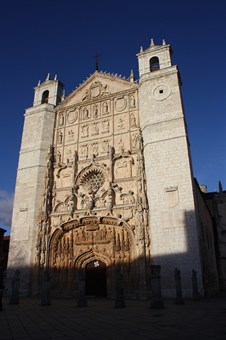The Church of San Pablo and Valladolid in the Early Modern period
 The city of Valladolid enjoyed its most prosperous period during the Early Modern age. In the sixteenth century, Valladolid joined the revolt of the comuneros (1520-1521) against Charles V, but the king’s subsequent forgiveness made it one of the capitals of his vast empire. King Philip II, who was born in Valladolid in 1527, particularly linked his name to the city and it was there that he celebrated his first marriage with Maria Manuela of PortugalMaria Emanuela d’Aviz (1527-1545) was the first of four wives of Philip II of Habsburg. The daughter of John III of Portugal and of one of the sisters of Charles V, Catherine of Habsburg, Maria Emanuela was therefore cousin of the then heir to the throne of Spain. From the marriage was born one son, Carlos. The queen died from complications in childbirth, at only 18 years of age.. Philip II’s decision to establish the court in Madrid in 1559 caused serious damage to the economy of Valladolid, but the king did not forget his hometown when a huge fire destroyed it in 1561. His direct intervention facilitated the reconstruction of the city, the symbol of which is the Plaza Mayor. Valladolid had a new but short-lived heyday in the early seventeenth century, when King Philip III and his favourite, the Duke of Lerma, decided to establish the court there. During the five years the monarch resided there (1601-1606), Valladolid reached the greatest moment in its history, greatly enriching its artistic heritage. During the Baroque period, the city experienced a serious economic and demographic crisis (like all Castile), but also underwent a period of cultural and artistic wealth of which today, unfortunately, few traces remain because of nefarious urban renewal conducted between the nineteenth and twentieth centuries.
The city of Valladolid enjoyed its most prosperous period during the Early Modern age. In the sixteenth century, Valladolid joined the revolt of the comuneros (1520-1521) against Charles V, but the king’s subsequent forgiveness made it one of the capitals of his vast empire. King Philip II, who was born in Valladolid in 1527, particularly linked his name to the city and it was there that he celebrated his first marriage with Maria Manuela of PortugalMaria Emanuela d’Aviz (1527-1545) was the first of four wives of Philip II of Habsburg. The daughter of John III of Portugal and of one of the sisters of Charles V, Catherine of Habsburg, Maria Emanuela was therefore cousin of the then heir to the throne of Spain. From the marriage was born one son, Carlos. The queen died from complications in childbirth, at only 18 years of age.. Philip II’s decision to establish the court in Madrid in 1559 caused serious damage to the economy of Valladolid, but the king did not forget his hometown when a huge fire destroyed it in 1561. His direct intervention facilitated the reconstruction of the city, the symbol of which is the Plaza Mayor. Valladolid had a new but short-lived heyday in the early seventeenth century, when King Philip III and his favourite, the Duke of Lerma, decided to establish the court there. During the five years the monarch resided there (1601-1606), Valladolid reached the greatest moment in its history, greatly enriching its artistic heritage. During the Baroque period, the city experienced a serious economic and demographic crisis (like all Castile), but also underwent a period of cultural and artistic wealth of which today, unfortunately, few traces remain because of nefarious urban renewal conducted between the nineteenth and twentieth centuries.
The Church of San Pablo (Saint Paul, in the picture) can be taken as a symbol of the history of Valladolid in Medieval and Modern times and the changes experienced during the Baroque era. It is located in the Plaza de San Pablo, close to other historic sites such as the Royal Palace and the Pimentel Palace (the birthplace of Philip II), the Colegio de San Gregorio (College of Saint Gregory) now the Museo Nacional de Escultura (National Sculpture Museum) of Valladolid. The Dominican convent of San Pablo was founded in 1276 by Queen Violant of AragonYolanda or Violant of Hungary (1215-1251) was the daughter of King Andrew II of Hungary and the Princess of Constantinople Yolanda de Courtenay. In 1235 she married King Jaume I of Aragon (1208-1276), thus becoming queen consort of his vast possessions: the kingdoms of Aragon, Valencia and Mallorca, the county of Barcelona, the lordship of Montpellier and other fiefs in Occitania. Among the couple’s children, were Peter III the Great (1239-1285), the King of Aragon and Valencia, and Jaume II of Majorca (1243-1311) King of Majorca and Lord of Occitan, land he inherited from his father., but the construction of the church lasted for many years, including additions and renovations, in the fifteenth and sixteenth centuries. In 1518 the Cortes proclaimed Charles V king and it was there that Philip II was baptized as was his grandson Philip IV. At the beginning of the seventeenth century, under the patronage of the Duke of Lerma, the façade was extended, the two towers were built, the interior was enriched with many works of art and the structure underwent some major changes. The Sandoval family’s insignia are ever present on the façade, particularly in the upper part, and the Duke of Lerma was buried there in the Capilla Mayor along with his wife. There are still two great funerary sculptures in bronze of the valido and his wife, now held by the Museo Nacional de Escultura. Inside the church you can also admire some works by Gregorio Fernández, the main Castilian sculptor of the Baroque period, including a Cristo yacente (Dead Christ). Desecrated and damaged by Napoleon’s troops and in later centuries by men and fire, the church has been restored several times, while the adjacent convent was demolished in the nineteenth century.
